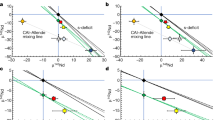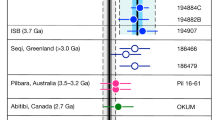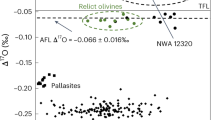Abstract
Small isotopic differences in the atomic abundance of neodymium-142 (142Nd) in silicate rocks represent the time-averaged effect of decay of formerly live samarium-146 (146Sm) and provide constraints on the timescales and mechanisms by which planetary mantles first differentiated1,2,3,4. This chronology, however, assumes that the composition of the total planet is identical to that of primitive undifferentiated meteorites called chondrites. The difference in the 142Nd/144Nd ratio between chondrites and terrestrial samples may therefore indicate very early isolation (<30 Myr from the formation of the Solar System) of the upper mantle or a slightly non-chondritic bulk Earth composition5,6. Here we present high-precision 142Nd data for 16 martian meteorites and show that Mars also has a non-chondritic composition. Meteorites belonging to the shergottite subgroup define a planetary isochron yielding an age of differentiation of 40 ± 18 Myr for the martian mantle. This isochron does not pass through the chondritic reference value (100 × ε142Nd = -21 ± 3; 147Sm/144Nd = 0.1966)6. The Earth, Moon and Mars all seem to have accreted in a portion of the inner Solar System with ∼5 per cent higher Sm/Nd ratios than material accreted in the asteroid belt. Such chemical heterogeneities may have arisen from sorting of nebular solids or from impact erosion of crustal reservoirs in planetary precursors. The 143Nd composition of the primitive mantle so defined by 142Nd is strikingly similar to the putative endmember component ‘FOZO’ characterized by high 3He/4He ratios7,8.
This is a preview of subscription content, access via your institution
Access options
Subscribe to this journal
Receive 51 print issues and online access
$199.00 per year
only $3.90 per issue
Buy this article
- Purchase on Springer Link
- Instant access to full article PDF
Prices may be subject to local taxes which are calculated during checkout


Similar content being viewed by others
References
Harper, C. L. & Jacobsen, S. B. Evidence from coupled 147Sm–143Nd and 146Sm–142Nd systematics for very early (4.5 Gyr) differentiation of the Earth's mantle. Nature 360, 728–732 (1992)
Harper, C. L., Nyquist, L. E., Bansal, B., Wiesmann, H. & Shih, C.-Y. Rapid accretion and early differentiation of Mars indicated by 142Nd/144Nd in SNC meteorites. Science 267, 213–217 (1995)
Caro, G., Bourdon, B., Birck, J.-L. & Moorbath, S. 146Sm–142Nd evidence for early differentiation of the Earth's mantle. Nature 423, 428–432 (2003)
Nyquist, L. E. et al. 146Sm–142Nd formation interval for the lunar mantle. Geochim. Cosmochim. Acta 13, 2817–2837 (1995)
Boyet, M. & Carlson, R. W. 142Nd evidence for early (>4.53 Ga) global differentiation of the silicate Earth. Science 309, 576–581 (2005)
Carlson, R. W., Boyet, M. & Horan, M. Chondrite barium, neodymium and samarium isotopic heterogeneity and early Earth differentiation. Science 316, 1175–1178 (2007)
Hart, S. R., Hauri, H. E., Oschmann, L. A. & Whitehead, J. A. Mantle plumes and entrainment: Isotopic evidence. Science 256, 517–520 (1992)
Stracke, A., Hofmann, A. W. & Hart, S. R. FOZO, HIMU, and the rest of the mantle zoo. Geochem. Geophys. Geosyst. 6 Q05007 10.1029/2004GC000824 (2005)
Prinzhofer, D. A., Papanastassiou, D. A. & Wasserburg, G. J. Samarium–neodymium evolution of meteorites. Geochim. Cosmochim. Acta 56, 797–815 (1992)
Ranen, M. C. & Jacobsen, S. B. Barium isotopes in chondritic meteorites: Implications for planetary reservoir models. Science 314, 809–812 (2006)
Andreasen, R. & Sharma, M. Solar nebula heterogeneity in p-process samarium and neodymium isotopes. Science 314, 806–809 (2006)
Caro, G., Bourdon, B., Birck, J.-L. & Moorbath, S. High-precision 142Nd/144Nd measurements in terrestrial rocks: Constraints on the early differentiation of the Earth's mantle. Geochim. Cosmochim. Acta 70, 164–191 (2006)
Caro, G., Bourdon, B., Wood, B. J. & Corgne, A. Trace element fractionation generated by melt segregation from a magma ocean. Nature 436, 246–249 (2005)
Bourdon, B. & Caro, G. The early terrestrial crust. C. R. Geosci. 339, 928–936 (2007)
Andreasen, R., Sharma, M., Subbarao, K. V. & Viladkar, S. G. Where on Earth is the enriched Hadean reservoir? Earth Planet. Sci. Lett. 266, 14–28 (2007)
Boyet, M. & Carlson, R. W. A new geochemical model for the Earth's mantle inferred from 146Sm–142Nd systematics. Earth Planet. Sci. Lett. 250, 254–268 (2006)
Jagoutz, E. Chronology of SNC meteorites. Space Sci. Rev. 56, 13–22 (1991)
Foley, C. N. et al. The early differentiation history of Mars from 182W-142Nd isotope systematics in the SNC meteorites. Geochim. Cosmochim. Acta 69, 4557–4571 (2005)
Borg, L. E., Nyquist, L. E., Wiesmann, H., Shih, C.-Y. & Reese, Y. The age of Dar al Gani 476 and the differentiation history of the martian meteorites inferred from their radiogenic isotopic systematics. Geochim. Cosmochim. Acta 67, 3519–3536 (2003)
Jagoutz, E., Jotter, R. & Dreibus, G. Evolution of six SNC meteorites with anomalous neodymium-142. Meteor. Planet. Sci. 35, A83–A84 (abstr.) (2000)
Lee, D.-C. & Halliday, A. N. Core formation on Mars and differentiated asteroids. Nature 388, 854–857 (1997)
Debaille, V., Brandon, A. D., Yin, Q. Z. & Jacobsen, B. Coupled 142Nd–143Nd evidence for a protracted magma ocean in Mars. Nature 450, 525–528 (2007)
Kleine, T., Mezger, K., Munker, C., Palme, H. & Bischoff, A. 182Hf–182W isotope systematics of chondrites, eucrites, and martian meteorites: Chronology of core formation and early differentiation in Vesta and Mars. Geochim. Cosmochim. Acta 68, 2935–2946 (2004)
Rankenburg, K., Brandon, A. D. & Neal, C. R. Neodymium isotope evidence for a chondritic composition of the Moon. Science 312, 1369–1372 (2006)
Boyet, M. & Carlson, R. W. A highly depleted moon or a non-magma ocean origin for the lunar crust? Earth Planet. Sci. Lett. 262, 505–516 (2007)
Jacobsen, S. B. & Wasserburg, G. J. Sm–Nd evolution of chondrites and achondrites, II. Earth Planet. Sci. Lett. 67, 137–150 (1984)
Hewins, R. H. & Herzberg, C. T. Nebular turbulence, chondrule formation, and the composition of the Earth. Earth Planet. Sci. Lett. 144, 1–7 (1996)
Cuzzi, J. N., Hogan, R. C., Paque, J. M. & Dobrovolskis, A. R. Size-selective concentration of chondrules and other small particles in protoplanetary nebula turbulence. Astrophys. J. 546, 496–508 (2001)
Agnor, C. & Asphaug, E. Accretion efficiency during planetary collisions. Astrophys. J. 613, L157–L160 (2004)
Kellogg, J. B., Jacobsen, S. B. & O'Connell, J. Modeling the distribution of isotopic ratios in geochemical reservoirs. Earth Planet. Sci. Lett. 304, 183–202 (2002)
Acknowledgements
We thank T. Kleine for critical discussion and an informal review of the manuscript, and S. Jacobsen for a constructive review. This study was supported by the CNRS research programme PNP.
Author information
Authors and Affiliations
Corresponding author
Supplementary information
Supplementary Information
The file contains Supplementary Tables S1-S2, Supplementary Figure S1 with Legend and additional references. (PDF 433 kb)
Rights and permissions
About this article
Cite this article
Caro, G., Bourdon, B., Halliday, A. et al. Super-chondritic Sm/Nd ratios in Mars, the Earth and the Moon. Nature 452, 336–339 (2008). https://doi.org/10.1038/nature06760
Received:
Accepted:
Issue Date:
DOI: https://doi.org/10.1038/nature06760
This article is cited by
-
Petrogenesis and U–Pb zircon dating of amphibolite in the Mewengo iron deposit, Nyong series, Cameroon: fingerprints of iron depositional geotectonic setting
Arabian Journal of Geosciences (2021)
-
Martian magmatism from plume metasomatized mantle
Nature Communications (2018)
-
Hadean silicate differentiation preserved by anomalous 142Nd/144Nd ratios in the Réunion hotspot source
Nature (2018)
-
Feedstocks of the Terrestrial Planets
Space Science Reviews (2018)
-
Mantle geochemistry: Insights from ocean island basalts
Science China Earth Sciences (2017)
Comments
By submitting a comment you agree to abide by our Terms and Community Guidelines. If you find something abusive or that does not comply with our terms or guidelines please flag it as inappropriate.



